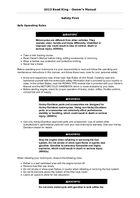Cleaning and Inspection
Battery top must be clean and dry. Dirt and electrolyte on top of the battery can cause battery to
self discharge.
1. Clean battery top.
2. Clean cable connectors and battery terminals using a wire brush or fine grit sandpaper to
remove any oxidation.
3. Inspect and clean the battery screws, clamps and cables. Check for breakage, loose
connections and corrosion.
4. Check the battery posts for melting or damage caused by overtightening.
5. Inspect the battery for discoloration, a raised top or a warped or distorted case. This might
indicate that the battery has been frozen, overheated or overcharged.
6. Inspect the battery case for cracks or leaks.
Charging
An automatic, constant monitoring battery charger/tender with a charging rate of 5 amps or less at
less than 14.6 volts is recommended. The use of constant current chargers (including trickle
chargers) to charge sealed AGM batteries is not recommended. Any overcharge will cause dry
out and premature battery failure. Never charge a battery without first reviewing the instructions
for the charger being used. In addition to the manufacturer's instructions, follow these general
safety precautions.
Charge the battery if any of the following conditions exist:
Vehicle lamps appear dim.
Electric starter sounds weak.
Battery has not been used for an extended period of time.
Explosive hydrogen gas, which escapes during charging,
could cause death or serious injury. Charge battery in a
well ventilated area. Keep open flames, electrical sparks
and smoking materials away from battery at all times.
KEEP BATTERIES AWAY FROM CHILDREN. (00065a)
Batteries contain sulfuric acid, which could cause severe
burns to eyes and skin. Wear a protective face shield,
rubberized gloves and protective clothing when working
with batteries. KEEP BATTERIES AWAY FROM CHILDREN.
(00063a)
1. Perform a voltmeter test to determine the state of charge. If battery needs to be charged,
proceed to the next step.
2. Place the battery on a level surface.




















































































































































































